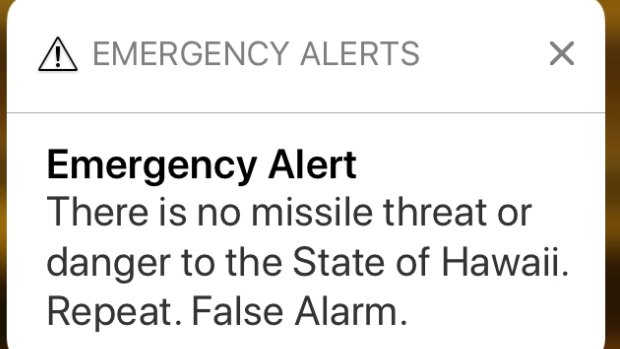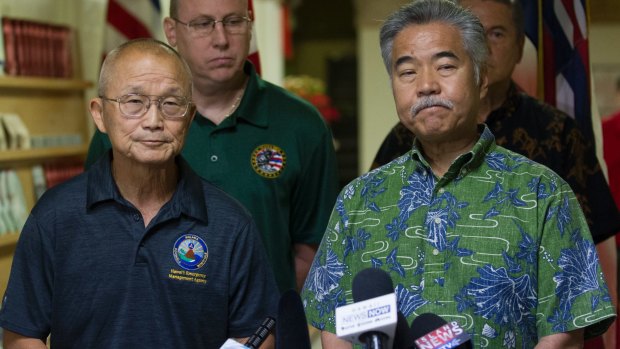By Eric Schlosser
At one point or another, when confronted by a drop-down menu on a computer screen, just about everyone has chosen the wrong option. It's usually a trivial mistake, easily corrected, that momentarily selects shoes that are too big or a one-way flight instead of round-trip. Last Saturday at 8.05am, an operator at the Hawaii Emergency Management Agency inadvertently chose "missile alert" instead of "test missile alert", setting off sirens across the state, sending messages to thousands of phones that implied a nuclear attack, broadcasting similar warnings on radio and television, and scaring the hell out of a lot of people.
Unlike most drop-down menus, however, this one lacked an option to correct the mistake. There was "no cancellation button", a spokesman for the emergency agency told The Washington Post. As a result, it took almost 40 minutes for the system to reassure the public that intercontinental ballistic missiles were not on their way to Honolulu.

This smartphone screen capture shows the retraction of an incorrect incoming ballistic missile emergency.Credit: CALEB JONES
In the realm of nuclear accidents and false alarms, the Hawaii event wasn't especially serious or dangerous. It involved a civilian, not a military, early warning system. But it shared a common cause with accidents that could have proven truly catastrophic: a seemingly trivial but unanticipated error disrupting the workings of a complex technological system.
In 1960, America's Ballistic Missile Early Warning System claimed with 99.9 percent certainty that the Soviet Union had launched an all-out nuclear attack. The false alarm was prompted by a radar in Greenland, which mistook the rising of the moon for dozens of missiles. In 1979, someone left a training tape of a war game in a North American Air Defense (NORAD) computer, causing another warning of an all-out Soviet nuclear attack on the United States. The Soviet early warning system was even more unreliable, bringing the world to the brink of nuclear war on at least two occasions, most recently in 1995, when a Norwegian weather rocket was wrongly identified as a ballistic missile launched from an American submarine.

HEMA administrator Vern Miyagi, left, and Hawaii Governor David Ige address the media at the Hawaii Emergency Management Centre after the false alarm.Credit: GEORGE F. LEE
Nuclear weapon accidents have been caused by all sorts of trivial things. In 1957, an unarmed hydrogen bomb was dropped on Albuquerque, New Mexico, when the crew member of a B-36 bomber grabbed a handle to steady himself amid air turbulence. Unfortunately, the handle was the manual bomb release. A year later, an unarmed atomic bomb was dropped into the backyard of a suburban home in Mars Bluff, South Carolina, when the crew member of a B-47 bomber inadvertently did exactly the same thing. In 1980, a maintenance technician dropped a tool inside the silo of a Titan II missile destroying the missile and launching America's most powerful nuclear warhead into a ditch.
One of the lessons to be learnt from these stories is human beings are better at creating technological systems than controlling them – or knowing what to do with them when something goes wrong. Every machine ever invented eventually goes wrong, from the coffee-maker that dies when you're desperate for caffeine to the commercial airliner that vanishes over the Pacific without a trace. Nuclear weapons are the most dangerous machines ever built – and when they go wrong, potentially millions of people can be killed. And the technological systems that control these weapons are equally vulnerable, whether it's a glitch in an early warning system or a flaw in a computer.
There's a tendency to blame human error when something goes wrong, to blame the maintenance technician who dropped the tool or the operator who selected the incorrect menu option. But the real human error lies in creating systems that are vulnerable to catastrophic failure when something relatively trivial happens.
The nuclear threat may seem abstract and remote to most Australians. But the early warning radars at the Joint Defence Facility Pine Gap in Alice Springs are a crucial node in America's nuclear command-and-control system. They would be among the first targets to be hit by an adversary launching a nuclear surprise attack against the US. And North Korea not only has ballistic missiles that can hit Pine Gap but has threatened to impose a "disaster" on Australia for its support of American policies.

Eric Schlosser's multimedia piece The Bomb will be performed at the Sydney Festival.Credit: Mark Mann
Moreover, no country is safe from the nuclear threat. The effects of a nuclear detonation show little respect for national borders. A relatively small nuclear war between India and Pakistan, involving about one hundred weapons, would have worldwide atmospheric effects and cause hundreds of millions of casualties.
William J. Perry, who served as secretary of defence during the Clinton administration, believes the threat of a deliberate or accidental nuclear catastrophe is greater today than it was during the Cold War. More than a decade ago, Perry joined former US senator Sam Nunn and two former secretaries of state, Henry Kissinger and George P. Shultz, in calling for the abolition of nuclear weapons. Then-president Barack Obama later endorsed their support for abolition and the International Campaign to Abolish Nuclear Weapons (ICAN) won last year's Nobel Peace Prize for seeking that goal.
The alternative to abolishing nuclear weapons is fully embracing the faith that machines will always work perfectly, computers will never go wrong, and nobody will ever push the wrong button. The last nuclear weapon to detonate on Australian soil – the Taranaki test at Maralinga on October 9, 1957 – had an explosive force almost twice as strong as that of the bomb that destroyed Hiroshima. Unless there is a worldwide campaign to eliminate these weapons, with massive demonstrations like the ones that helped to end the Cold War peacefully, Taranaki may turn out not to be the last one, after all.
Eric Schlosser is the author of the book Command and Control and co-creator of the multimedia piece The Bomb, which will be performed at Sydney Festival next week.